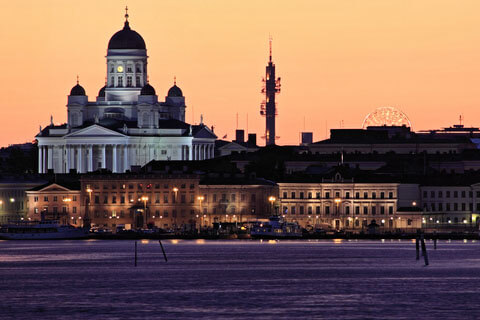Strolls through Helsinki – the metropolis shaped by water
It is the magic of the sea and the art of simplicity that makes Helsinki, Finland, arguably one of the most beautiful metropolises in the world. Helsinki is still shaped by the sea today.

The numerous ships that arrive daily in the Finnish capital almost reach the city center. But also the marketplace, which is located directly on the sea, is characterized by a fabulous flair.
While Helsinki in winter often leaves the impression that the metropolis is in hibernation, it comes to life during the summer. In the numerous street cafes young and old cavort to enjoy the warm rays of the sun.
Helsinki has always been the daughter of the Baltic Sea and has managed to retain this status until today. For the most part, the capital of Finland is situated on a highly rugged granite peninsula.
A breathtaking tourist experience already awaits visitors at the gates of the metropolis. The offshore cliffs and islands form a labyrinth that is unique and extraordinary at the same time.
Although at first glance Helsinki may appear to be a very old metropolis, it is one of the youngest in the world.
Only after Finland was conquered by Russia, the Russian tsar arranged for the transfer of the Finnish capital from Turku to Helsinki.
Helsinki was better suited as the capital because of its proximity to Russia. Since 1812, it has assumed this role with a pride that is second to none.
In the past, the city was repeatedly hit by strokes of fate. The numerous fires have mainly destroyed the Swedish heritage, which could remind of the beginnings of Helsinki.
Today it is mainly the features of neoclassicism that characterize the cityscape and decorate it architecturally with diversity. The neoclassically designed city center is concentrated in the immediate vicinity of Senate Square and is an excellent starting point for excursions of all kinds.
Even today, the buildings recall a Finnish quotation of the grandeur of St. Petersburg. Even from a distance, the Orthodox churches of the city show themselves with all their splendor.
The Uspenski Cathedral is rightly one of Helsinki’s landmarks. It is the largest Orthodox church in the country and is characterized by red bricks.
Directly on the famous Senate Square stands the city’s cathedral church, decorated in white. It exudes elegance, if not a touch of solidity, and is one of the most beautiful buildings in the metropolis.
Helsinki is not only known for its numerous historical buildings, but also for the Esplanadi. With it presents the vibrant boulevard and shopping street of the city.
It is located directly on the busy market square. Compared to many other capitals in the world, Helsinki’s city center is very small. Starting from the market square, it can be easily explored on foot.
Helsinki as a festival city
Most people are drawn to Helsinki during the summer, when the city presents its welcoming and at the same time extremely friendly side.
But even though summer is undoubtedly the most beautiful season for a visit to the metropolis, it is worth taking a look beyond the horizon. Every year between the end of August and mid-September, Helsinki is transformed into a veritable festival city.
It is the time when the streams of tourists have long since gone home and the streets are quiet. From the end of August, concerts, theater and opera performances are held all over Helsinki. It is the time when culture once again has a firm grip on the metropolis.
Numerous readings and other cultural events make Helsinki as exciting and varied as no other city in Finland could be during these weeks.
The special thing about these festival days, are the different topics that are put into focus. Thus, there are numerous pubs that offer a place for performances under the motto “Art comes to the pub”.
The festival ends every year with the same highlight. For the Long Night of the Arts, the city celebrates around the clock and presents exciting events.
Helsinki’s heart – the city center
To this day, the city center is the heart of Helsinki. In the streets of the center one encounters a modern pulse, which at the same time is characterized by a certain nostalgia.
Without a doubt, the city center is a feast for the eyes, characterized by impressive architecture, but not least by its proximity to the sea. The showpiece of the city center is the market square.
Year-round, it offers a bustling market Monday through Saturday between 6:30 a.m. and 2 p.m., brought to life by numerous vendors. In the center of the market square is a tall obelisk.
It still commemorates the visit of Tsarina Alexandra Feódorovna in 1833. Boats leave from the marketplace for Suomenlinna and the archipelago, which is located in front of the city.
The marketplace is directly adjacent to the famous southern harbor. Ferries dock on both sides of the southern harbor, serving the line between Sweden and Finland.
At first sight, the old market hall catches the eye. It presents itself as a yellow-red brick building that captivates visitors with a picturesque charm. Already during the tsarist period the hall was built on the water side of Eteläranta.
Even today, the market hall shows itself as a social center. In it you can find numerous Finnish delicacies that bring to life the extraordinary range of the country’s typical cuisine.
In addition to fish of all kinds, the market hall advertises moose and reindeer meat. But fresh fruit and vegetables, typical Finnish baked goods and small cafés also make a visit to the market hall a treat for the human palate.
The Presidential Palace – impressive architecture with rich details
Around the market square, interesting buildings are strung like pearls on a necklace. One of the most beautiful buildings is the old town hall, located on the north side of the square.
It was built in 1833 by Carl Ludwig Engel. Once the building was to be used as a hotel. Today it is the light blue facade that makes it a pearl of urban architecture.
In the northeast corner of the square the view meets the famous Presidential Palace. Today it is used only for representational purposes. Originally, the palace was owned by a rich merchant.
However, in 1843 Engel remodeled it into the famous tsar’s residence. Directly behind the Presidential Palace is the city’s main police station.
At the entrance to the Esplanade Park presents the Havis Amanda. The ornamental fountain was penned by Ville Vallgren and is characterized by a nude statue of a girl and sea lions that act as gargoyles.
When the fountain was first unveiled, it caused a sensation throughout Finland. Today, it is one of the landmarks of the Finnish capital and therefore also one of the most famous places discovered by visitors.
A small bridge leads east from the market to the Katajanokka peninsula. Until the beginning of the 19th century, only a few small fishermen’s houses were found on the now extremely charming peninsula.
In later times, the site served primarily as a naval port. A far-reaching development occurred in the 1980s and 1990s. During this period, Katajanokka underwent urban redevelopment.
The goal was to create new housing for people and to counteract the out-migration that was plaguing the inner city. Today, the Katajanokka district presents Finnish Art Nouveau with all its facets. The best way to discover the district is during a walk.
Visitors should not be deterred by the six-story high-rises in any case, because most of them are home to a unique courtyard, which promises idyll and tranquility.
Helsinki Senate Square
One of the most famous destinations in the Finnish capital is the Senate Square. Senate Square is home to numerous historic buildings that recall past centuries and bring to life great moments in the city’s history.
Among them is the famous Knight’s House, built in 1861 by G. Th. Chiewitz was built. It is located in the well-known Aleksanterinkatu.
On the second floor of the building there is a banquet hall where visitors come across the coats of arms of the old Finnish noble houses. The former Senate building is located just a few steps from the Knight’s House.
Today, the building houses the seat of the Finnish government. Eugen Schaumann shot the well-known Russian Governor General Nikolai Bobrikoff in the stairwell of the Senate building in 1904.
If the eye falls on the left side, it meets the blue Sederholm house. It dates back to 1757 and is now the oldest stone building in Helsinki. Impressive and with a very special charm presents the Senate Square.
A bronze statue of Tsar Alexander II has stood here since 1894. The image was cast by Walter Runeberg. As Grand Duke Alexander founded the Finnish self-government. He also convened the Estates Day in 1864.
Helsinki’s Senate Square is still dominated by the Cathedral Church. The Lutheran church is located 10 meters above the square on a granite rock and is clearly visible even from a distance.
The cathedral church was designed according to the plans of Carl Ludwig Engel. It was once known as the Church of St. Nicholas, and its own name commemorated the then Tsar Nicholas.
It was not until 1852 that the cathedral church could be finished. In the process, it was built in a modified style. Mainly due to its position, the cathedral church developed into a landmark of Helsinki.
While the cathedral church radiates an unmistakable grandeur from the outside, it appears very plain on the inside.
The walls of the church are whitewashed in simple white. Jewelry and extensive paintings were deliberately omitted. Statues present themselves exclusively at the approaches of the dome pillars.

